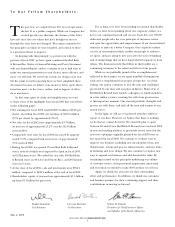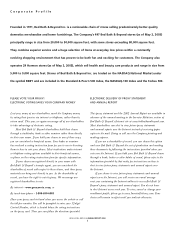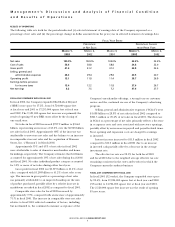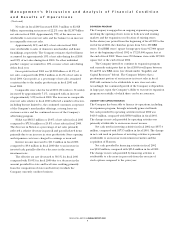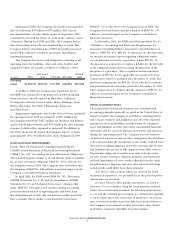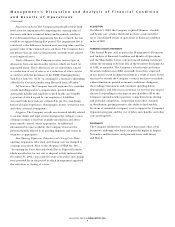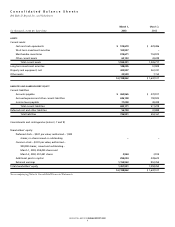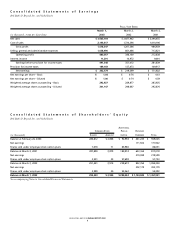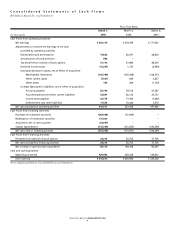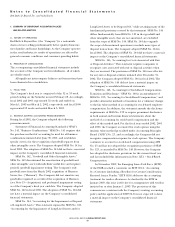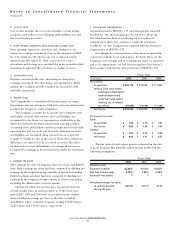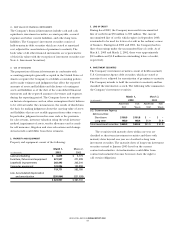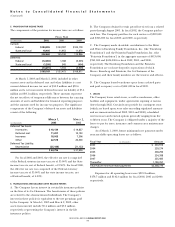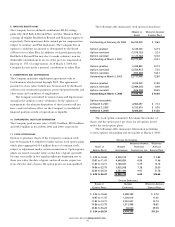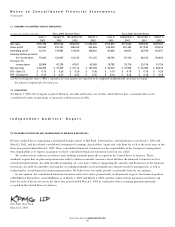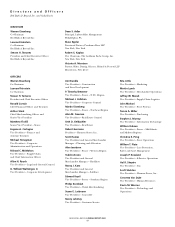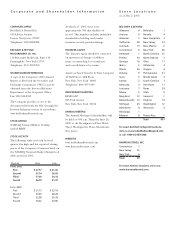Bed, Bath and Beyond 2002 Annual Report Download - page 13
Download and view the complete annual report
Please find page 13 of the 2002 Bed, Bath and Beyond annual report below. You can navigate through the pages in the report by either clicking on the pages listed below, or by using the keyword search tool below to find specific information within the annual report.
BED BATH & BEYOND ANNUAL REPORT 2002
11
E. CASH AND CASH EQUIVALENTS
The Company considers all highly liquid instruments purchased
with original maturities of three months or less to be cash
equivalents.
F. INVENTORY VALUATION
Merchandise inventories are stated at the lower of cost or market,
using the retail inventory method. Under the retail inventory
method, the valuation of inventories at cost and the resulting
gross margins are calculated by applying a cost-to-retail ratio
to the retail value of inventories. At any one time, inventories
include items that have been marked down to the Company’s best
estimate of their fair market value. Actual markdowns required
could differ from this estimate.
G. PROPERTY AND EQUIPMENT
Property and equipment are stated at cost. Depreciation is
computed primarily using the straight-line method over the
estimated useful lives of the assets (forty years for building; five
to ten years for furniture, fixtures and equipment; and three to
five years for computer equipment). Leasehold improvements
are amortized using the straight-line method over the lesser of
their estimated useful life or the life of the lease.
The cost of maintenance and repairs is charged to earnings
as incurred; significant renewals and betterments are capitalized.
Maintenance and repairs amounted to $34.7 million, $34.3
million and $28.4 million for fiscal 2002, 2001 and 2000,
respectively.
H. IMPAIRMENT OF LONG-LIVED ASSETS
The Company periodically reviews long-lived assets for
impairment by comparing the carrying value of the assets
with their estimated future undiscounted cash flows. If it is
determined that an impairment loss has occurred, the loss
would be recognized during that period. The impairment loss
is calculated as the difference between asset carrying values and
the present value of the estimated net cash flows. The Company
does not believe that any material impairment currently exists
related to its long-lived assets.
I. INVESTMENT SECURITIES
Investment securities consist of U.S. Government Agency debt
securities. Because the Company has the ability and intent to hold
the securities until maturity, it classifies its securities as held-to-
maturity. These investment securities are recorded at amortized
cost, adjusted for the amortization or accretion of premiums
or discounts.
Premiums and discounts are amortized or accreted over the
life of the related held-to-maturity securities as an adjustment to
interest using the effective interest method. Dividend and interest
income are recognized when earned.
J. DEFERRED RENT
The Company accounts for scheduled rent increases contained
in its leases on a straight-line basis over the noncancelable lease
term. Deferred rent amounted to $29.1 million and $26.5 million
as of March 1, 2003 and March 2, 2002, respectively.
K. SELF INSURANCE
The Company uses self insurance for a number of risks including
worker’s compensation, general liability, automobile liability
and employee related health care benefits (a portion of which is
paid by our employees). Liabilities associated with these risks are
estimated in part by considering historical claims experience,
demographic factors, severity factors and other actuarial
assumptions.
L. LITIGATION
The Company records an estimated liability related to various
claims and legal actions arising in the ordinary course of business
which is based on available information and advice from outside
counsel, where appropriate. As additional information becomes
available, the Company reassesses the potential liability related to
its pending litigation and revises its estimates as appropriate.
M. REVENUE RECOGNITION
Sales are recognized upon purchase by customers at our retail
stores or when shipped for products purchased from our websites.
The value of point of sale coupons and point of sale rebates
that result in a reduction of the price paid by the customer are
recorded as a reduction of sales. Shipping and handling fees that
are billed to a customer in a sale transaction are recorded in
sales. Revenues from gift cards, gift certificates and store credits
are recognized when redeemed. Sales returns, which are reserved
for based on historical experience, are provided for in the period
that the related sales are recorded.
N. VENDOR ALLOWANCES
The Company receives various types of allowances from our
merchandise vendors, which are based on negotiated terms.
These allowances are recorded when earned as a reduction
of cost of sales or as a reduction of other costs in accordance
with the provisions of EITF 02-16.


